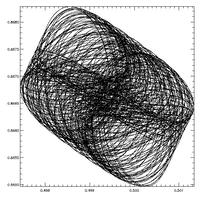T8: L-Points (restricted 3 body problem)
Before the tutorials:
Do, think about, and research the following:
- Bring your own program to the level of the example given for the last tutorial,
so that you can start from a clean and working version.
- How many L-Points does the sun-earth system have ?
- Which of them are stable ?
- Why ?
During the tutorials:
Program it!
- Set up the sun + earth system and place a test body (sattelite) into a stable L-Point.
Hint: give the earth a jupiter like mass to increase the size of the stable region.
- You can now perturb the position/velocity of the test particles and check the orbit it has.
Can you transform into the rotating frame and plot the orbit accordingly ?
Hint: You can transform the earth and the test body in polar coordinates and subtract
the phi you got for the earth from the phi coordinate of the test body.
Now you can transforming back the test body to Cartesian coordinates.
Example programs:
These are just examples.
- C/C++:
- F90:
- Simple version (this is sufficient for the moment, but it doesn’t hurt you to start improving it as suggested above):
T6.f90
(colorized),
Makefile
(colorized) (rename to “Makefile” or use with “make -f Makefile_gfortran”)
- More complex version:
(To be added later. We will reorganize the program structure when we get to multiple particles; think about how you would do this on your own.)
Discussion of the results:
Plot your results with gnuplot and plot the behaviour of the systems.
Can you explain what you see ?
Example plots:
Programming goals for T8:
Now you should got familiar with all you need in C++ for the goals of the tutorials !
